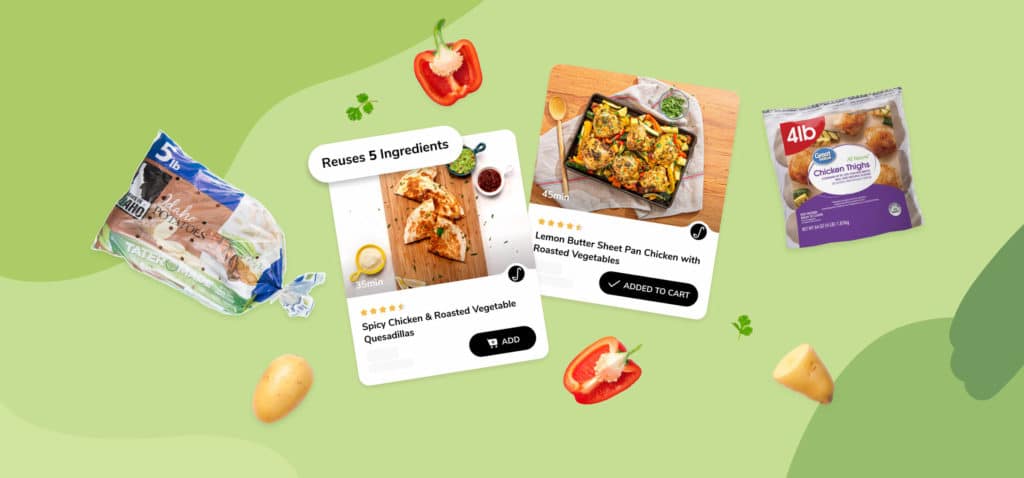
This is a story about the recipe. It’s a story about how technology and content came together to create a new way to cook.
The story of the recipe starts with inspiration. At the beginning of my career in technology, I had to consider the answer to a simple question: why do people cook? I have always worked with this type of content, but I am not a recipe developer. I work hands-on with technology across multiple platforms, but I am not a software developer. My love of food brought me to a food-tech startup where we imagined a world where everyone could cook.
What happened to home cooking? The early millennium brought Michelin star cooking to the mainstream, but home cooking had taken a bit of a detour. According to a 2010 poll, 8 in 10 U.S. adults watch cooking shows. More than half (57%) of those say they have purchased food directly from something they have seen on a cooking show. The edutainment of cooking spawned a generation of cooking show superfans, and cooking with confidence became synonymous with being a culinary master. While I and the rest of the world hung on every word and every flash in the pan from our culinary masters, this growing passion for cooking wasn’t translating into making everyday meals.
As people became busier, spending less time at home, there seemed to be a divergence between us and the generations who relished the time they spent cooking their go-to meals and creating memorable experiences. Our generation was the most innovative by far, yet as SideChef Founder and CEO Kevin Yu realized, creating an essential food experience like a Valentine’s Day dinner only ended in disaster.
How could we go from being spectators to confidently making memorable meals?
And the Roast is History
Early on, we imagined a world where SideChef was at the cornerstone of every shared meal. In 2013, SideChef launched to make cooking fun for everyone, in real life, right at home. The recipe was the content at the center of it all. We knew the traditional recipe could be more. It could be dynamic; it could be connected; it could be shoppable! Over time, it became clear that content combined with technology was essential to our success.
Why people cook will never change; how they cook will continually change. Creating a new guided cooking experience from beginning to end had its challenges.
It required taking the recipe off the printed page or blog post. We needed to address how much content was enough to create a personalized experience for every home cook.
Don’t forget about the structure of the recipe itself. How could you pull the rich ideas and expressions from a recipe, retain the uniqueness of the author’s voice, and put them in a cold, sterile technology box?
The experience of cooking is jam-packed with emotion. How could technology be added to the mix and remain its wholesome authentic self? How could we stay competitive and innovative and create future experiences with roles that address both content and technology as a joint function? We found our way to success, but it took a lot of ingenuity and hard work.

Taking it Step-by-Step
Building the cooking experience of the future starts with options. The internet allowed the cooking enthusiast to unlock recipes from the treasured past of others and cooking experiences from different cultures. Food blogs became the go-to source for food content, and bloggers were eager to share their passion projects. Content creators digitized recipes for consumption, and people were eating them up.
Digitizing recipes meant building proprietary tools that were the foundation of the guided cooking experience we wanted to see. Working with our software developers was essential in transforming the traditional format into the SideChef signature step-by-step format.
I invited hundreds of bloggers to share their recipes on SideChef, where home cooks could experience their recipes in a new way. I found thousands of recipes from all over the world, hundreds of different cuisines, and dietary niches. We had the most extensive, diversified recipe library to date. It was exciting to see and work with so many incredible content creators. With every new recipe came new ingredients, varied images and sizes, and new ways of describing instructions. It was an influx of metadata but also of varied user experiences. The strength of every recipe was its uniqueness, but at scale, it was apparent we needed a standard.
Feeling Out of Mise en Place
As our recipe numbers grew, it was evident that quality was just as important as quantity. We needed to improve how we provided our experience to users, and it started with the content. Personalized experiences mean more than the number of options, but how those options translate into what people want and what they expect to see. The truth is that there is more than one way to write a recipe; we just had to find our way.
We wanted to deliver an actual guided cooking experience, not just transposing content onto a mobile app like uploading an image into cloud storage. The content needed to be adaptable for multiple platforms across multiple channels. Although members of the Content Team are not recipe developers, it was essential to get extensive training in recipe writing.
We did a deep dive into how people cook with a recipe because things have changed. We gained better insight into every phase of the cooking journey, as those aspiring to cook were turning to mobile and web, deciding what to make, learning how to prepare it, and cooking or baking. It was important to enhance and provide personalized support in each micro-moment.
We analyzed our target customers and identified barriers — anything that stops someone from even thinking they can cook a recipe. We also identified triggers — every pause or moment of confusion that could happen while cooking. With the shared experience of cooking in mind, we were there to guide them every step of the way.
In the spring of 2019, we established the SideChef Recipe Optimization Style guide. This dynamic document would continually help guide our team to optimize recipes to ensure that we remove barriers and triggers that would otherwise detract from the optimal cooking experience. This multi-platform reference tool addresses how to work with the content paired with the technology that powers it for the best user experience. With this new way forward, we could find a way to retain the author’s unique voice and point of view while establishing a golden standard that SideChef could stand behind.
We took a more thoughtful approach to tagging recipe content while considering user search intent. We created a structured approach to optimizing, not uploading recipes into our signature smart recipe format. That’s right. While we were busy improving our content quality and content operations, we made our recipes smart.
“Do or Do Not. There is No Try.” – Yoda
Home cooking had already begun to change. SideChef was at the center of the most thrilling time for connected appliances, and we had to keep up. With the screen launch on the first generation of the Amazon Echo Show, the Content Team now optimized recipes for platforms outside the app and web. Social media platforms like Facebook Portal, Google Home, and Samsung Bixby soon followed suit, launching similar products with technology powered by SideChef.
SideChef became a significant player in the connected kitchen space with appliance partners like LG and forging long-standing initiatives with Electrolux and Panasonic, requiring more work on the recipe. The Internet of Things became the talk of the tech town, and we leveraged our two biggest strengths: content and technology. It was the same content but now structured, with an IoT twist. The work involved integrating the content that came from the established content strategy using the tools built by our software engineers to help realize the personalized experiences designed by our Product team. We worked closely with them to bring these experiences to life so that marketers could build a strong consumer-facing brand. We learned new technologies and programming languages with each new product and innovation. It was challenging, but we did it and continued to improve the quality of our content experiences every time.
The launch of shoppable recipes on SideChef and third-party sites powered by SideChef has been the latest innovation, a collective effort across teams. We have continued to launch capabilities using our ingredient database to power features that support nutrition, sustainability, and grocery. We needed to be familiar with the content and the technology that enables it. So we trained machine learning models to power the recommendation engines associated with grocery fulfillment. Now we have increased our grocery integration operations to support growing at scale.

Finding the Recipe for Success
I thought of how the Content Team supported our mission and vision for cooking, and I compared this with other Content Teams across various industries. My conclusion was that the name “Content Team” didn’t describe what we did. Was there a better way to describe our role in content? I began my research using two simple words I thought I had made up: “content engineering,” and I was surprised to find descriptions very similar to our work!
I found exciting material from those who continue to champion content intelligence like Colleen Jones, Cruce Saunders, Carrie Hane, and Mark Baker, to name a few. Seeing my work conceptualized into words was like a light bulb turning on. It showed me who we are and how much more we could be as a team and company. I had found the missing ingredient in our recipe for success — awareness.
Our success as a team has always come from delivering results and value against the odds. Now it seemed appropriate to rebrand the team — officially.
I lead the Content Engineering Team at SideChef, where we continue to unlock the power of content, but we no longer imagine a world where everyone can cook. We are engineering the content technology that bridges the gap to create new cooking experiences. It’s cooking with technology, reimagined.
Events, Resources, + More
The Ultimate Guide to End-to-End Content
Discover why + how an end-to-end approach is critical in the age of AI with this comprehensive white paper.
The Content Advantage Book
The much-anticipated third edition of the highly rated book by Colleen Jones is available at book retailers worldwide. Learn more!
20 Signs of a Content Problem in a High-Stakes Initiative
Use this white paper to diagnose the problem so you can achieve the right solution faster.
Upskill with Content Science Academy
Training for modern content roles through on-demand certifications + courses or live workshops.






Comments
We invite you to share your perspective in a constructive way. To comment, please sign in or register. Our moderating team will review all comments and may edit them for clarity. Our team also may delete comments that are off-topic or disrespectful. All postings become the property of
Content Science Review.